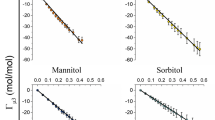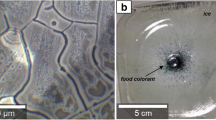Abstract
Purpose. Therapeutic antibodies are often formulated at a high concentration where they may have an opalescent appearance. The aim of this study is to understand the origin of this opalescence, especially its relationship to noncovalent association and physical stability.
Methods. The turbidity and the association state of an IgG1 antibody were investigated as a function of concentration and temperature using static and dynamic light scattering, nephelometric turbidity, and analytical ultracentrifugation.
Results. The antibody had increasingly opalescent appearance in the concentration range 5-50 mg/ml. The opalescence was greater at refrigerated temperature but was readily reversible upon warming to room temperature. Turbidity measured at 25°C was linear with concentration, as expected for Rayleigh scatter in the absence of association. In the concentration range 1-50 mg/ml, the weight average molecular weights were close to that expected for a monomer. Zimm plot analysis of the data yielded a negative second virial coefficient, indicative of attractive solute-solute interactions. The hydrodynamic diameter was independent of concentration and remained unchanged as a function of aging at room temperature.
Conclusions. The results indicate that opalescent appearance is not due to self-association but is a simple consequence of Rayleigh scatter. Opalescent appearance did not result in physical instability.
Similar content being viewed by others
References
O. H. Brekke and I. Sandlie. Therapeutic antibodies for human diseases at the dawn of the twenty-first century. Nat. Rev. Drug Discov. 2:52-62 (2003).
M. Trikha, L. Yan, and M. T. Nakada. Monoclonal antibodies as therapeutics in oncology. Curr. Opin. Biotechnol. 13:609-614 (2002).
E. Andreakos, P. C. Taylor, and M. Feldmann. Monoclonal antibodies in immune and inflammatory diseases. Curr. Opin. Biotechnol. 13:615-620 (2002).
S. A. Marshall, G. A. Lazar, A. J. Chirino, and J. R. Desjarlais. Rational design and engineering of therapeutic proteins. Drug Discov. Today 8:212-221 (2003).
Package inserts or prescribing information for Herceptin (Genentech, San Francisco, CA, USA), Remicade (Centocor, Malvern, PA, USA), Simulect (Novartis, Basel, Switzerland), and Synagis (MedImmune, Inc., Gaithersburg, MD).
H. Schellekens. Bioequivalence and immunogenecity of biopharmaceuticals. Nat. Rev. Drug Discov. 1:457-462 (2002).
J. F. Carpenter and M. C. Manning. Rational Design of Stable Protein Formulations: Theory and Practice, Kluwer Academic/Plenum Publishers, New York, 2002.
K. E. van Holde. Physical Biochemistry, Prentice-Hall, Englewood Cliffs, NJ, 1985.
T. M. Schuster and T. M. Laue. Modern Analytical Ultracentrifugation, Birkhäuser, Boston, 1994.
G. Rivas, J. A. Fernandez, and A. P. Minton. Direct observation of the self-association of dilute proteins in the presence of inert macromolecules at high concentration via tracer sedimentation equilibrium: theory, experiment and biological significance. Biochemistry 38:9379-9388 (1999).
J. Wen, T. Arakawa, and J. S. Philo. Size-exclusion chromatography with on-line light-scattering, absorbance, and refractive index detectors for studying proteins and their interactions. Anal. Biochem. 240:155-166 (1996).
H. G. Barth, B. E. Boyes, and C. Jackson. Size exclusion chromatography. Anal. Chem. 66:595R-620R (1994).
K. Monkos and B. Turczynski. A comparative study on viscosity of human, bovine and pig IgG immunoglobulins in aqueous solutions. Int. J. Biol. Macromol. 26:155-159 (1999).
E. J. Cohn and J. T. Edsall. Proteins, Amino Acids and Peptides as Ions and Dipolar Ions, Reinhold, New York, 1943.
A. P. Minton. Quantitative characterization of reversible macromolecular associations via sedimentation equilibrium: an introduction. Exp. Mol. Med. 32:1-5 (2000).
European Pharmacopoeia. Fourth Edition., Directorate for the Quality of Medicines of the Council of Europe (EDQM), Fourth Ed., Strasbourg, France (2001).
R. Wirestam, V. A. Larsen, M. Stubgaard, C. Thomsen, B. Vikhoff, H. B. Larsson, F. Stahlberg, and O. Henriksen. Deuterium MR spectroscopy at 4.7 T. Quantification of tumour and subcutaneous tissue blood flow in animal models. Acta Radiol. 36:85-91 (1995).
C. Binder. Absorption of injected insulin. Acta Pharmacol. Toxicol. (Copenh.) 27(Suppl. 2):1-87 (1969).
J. Brange, D. R. Owens, S. Kang, and A. Volund. Monomeric insulins and their experimental and clinical applications. Diabetes Care 13:923-954 (1990).
D. L. Bakaysa, J. Radziuk, H. A. Havel, M. L. Brader, S. Li, S. W. Dodd, J. M. Beals, A. H. Pekar, and D. N. Brems. Physicochemical basis for the rapid time-action of LysB28ProB29-insulin: dissociation of a protein-ligand complex. Protein Sci. 5:2521-2531 (1996).
J. A. Thomson, P. Schurtenberger, G. M. Thurston, and G. B. Benedek. Binary liquid phase separation and critical phenomena in a protein/water solution. Proc. Natl. Acad. Sci. U.S.A. 84:7079-7083 (1987).
C. Ishimoto and T. Tanaka. Critical behavior of a binary mixture of protein and salt water. Phys. Rev. Lett. 39:474-477 (1977).
Author information
Authors and Affiliations
Corresponding author
Rights and permissions
About this article
Cite this article
Sukumar, M., Doyle, B.L., Combs, J.L. et al. Opalescent Appearance of an IgG1 Antibody at High Concentrations and Its Relationship to Noncovalent Association. Pharm Res 21, 1087–1093 (2004). https://doi.org/10.1023/B:PHAM.0000032993.98705.73
Issue Date:
DOI: https://doi.org/10.1023/B:PHAM.0000032993.98705.73




